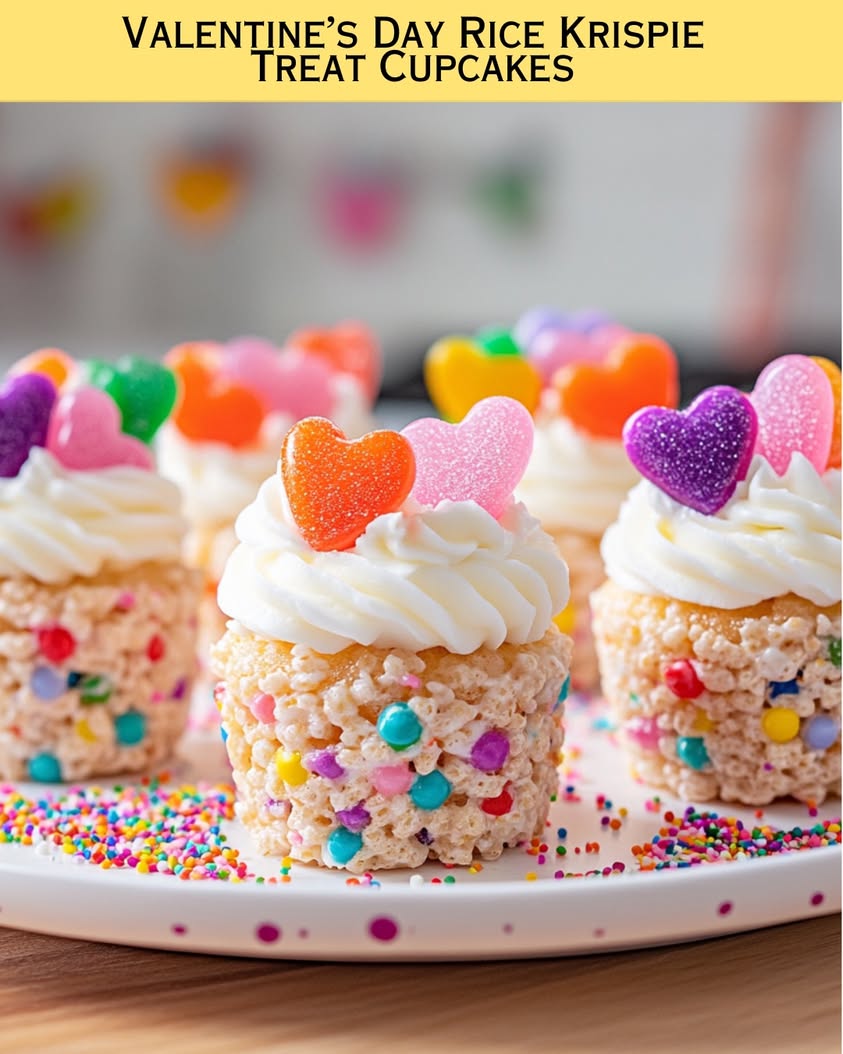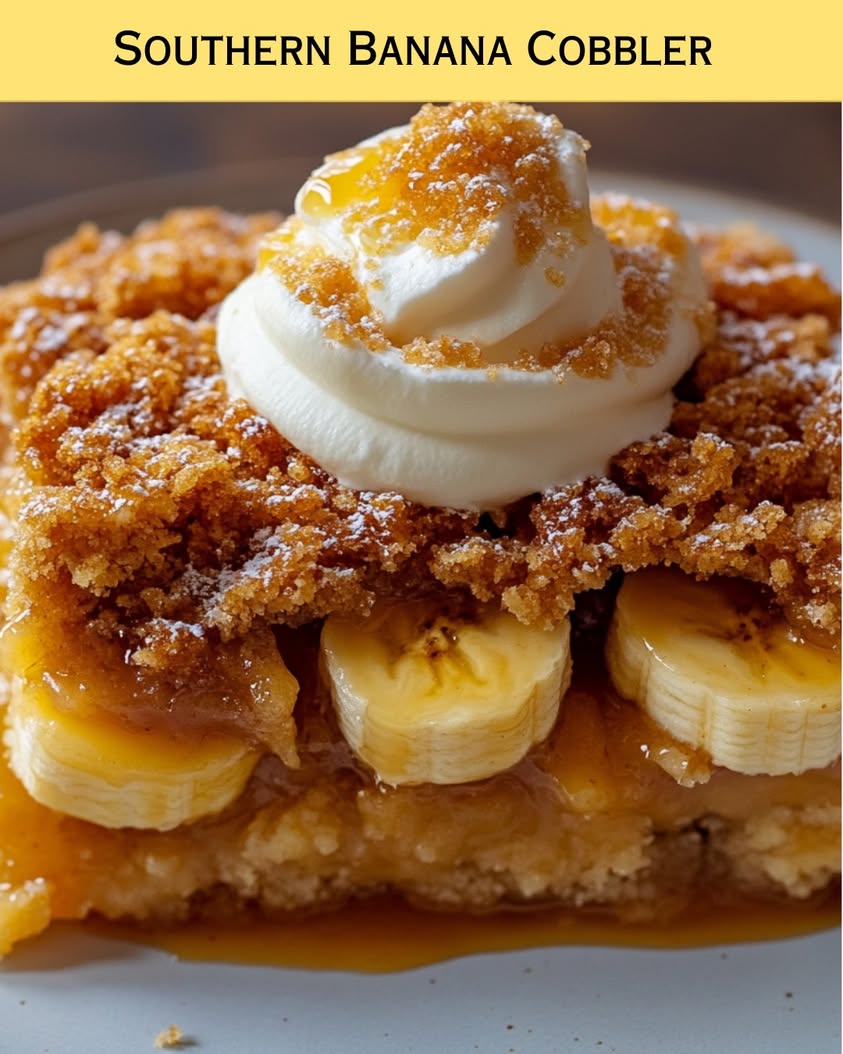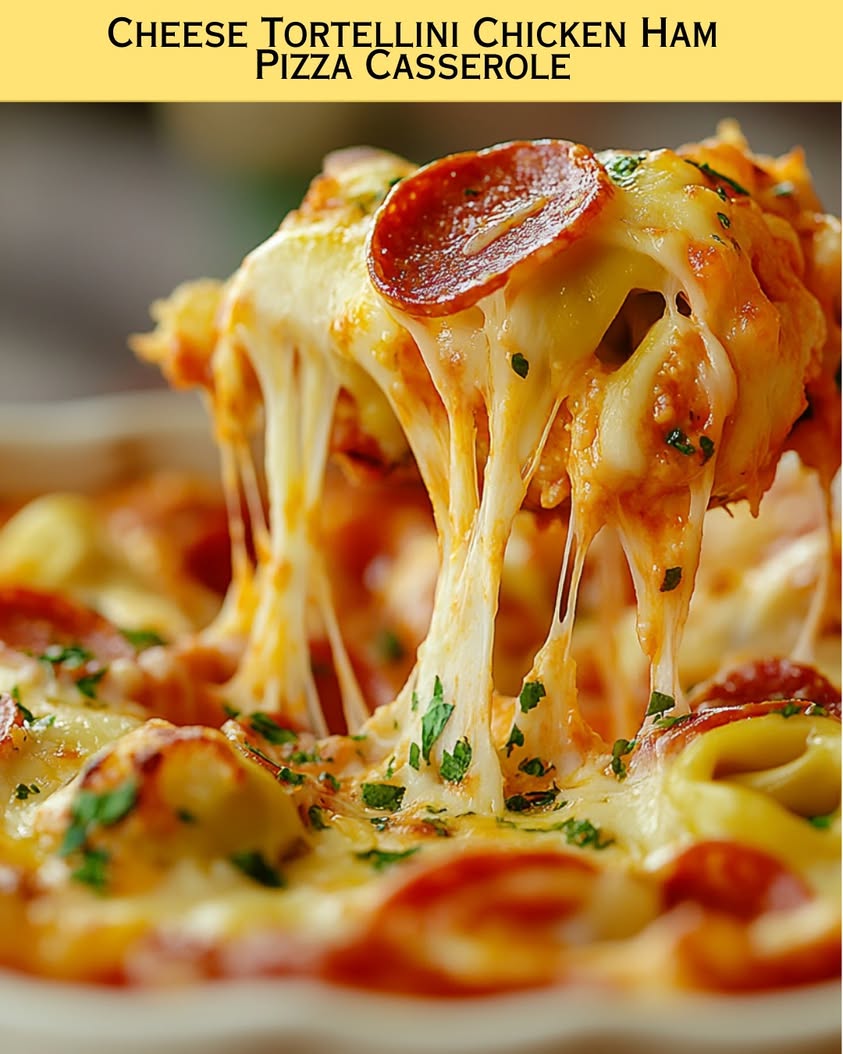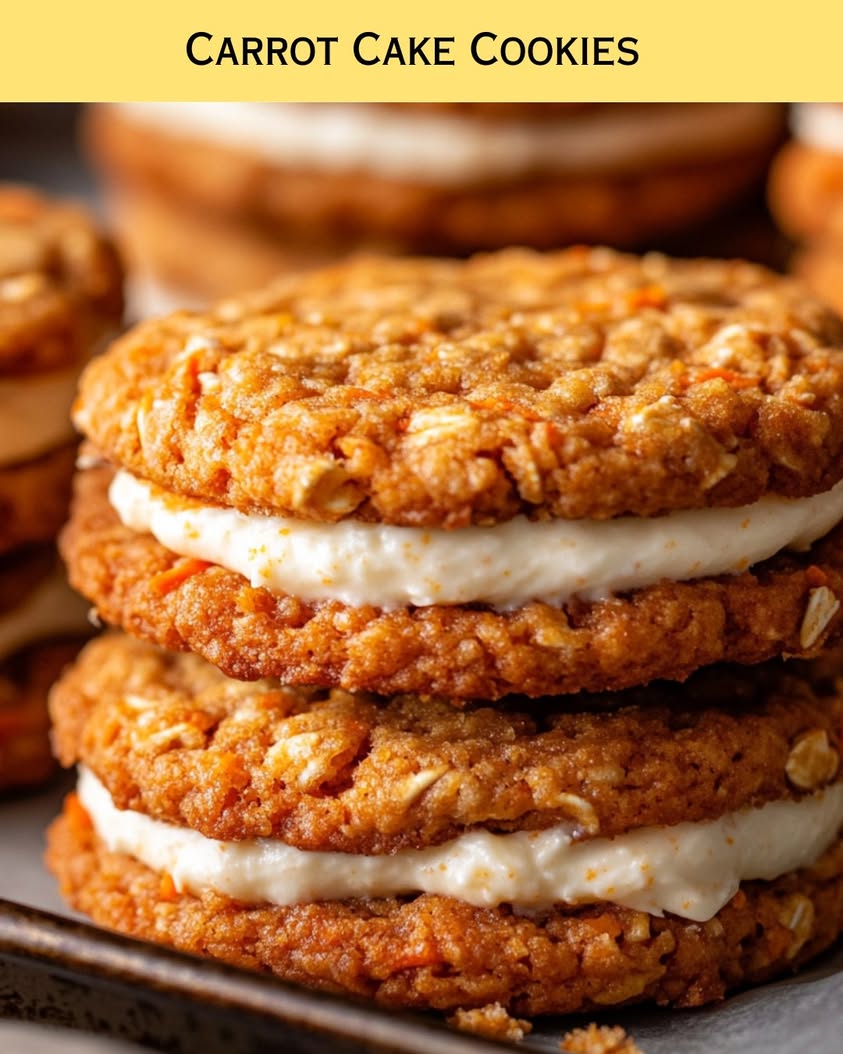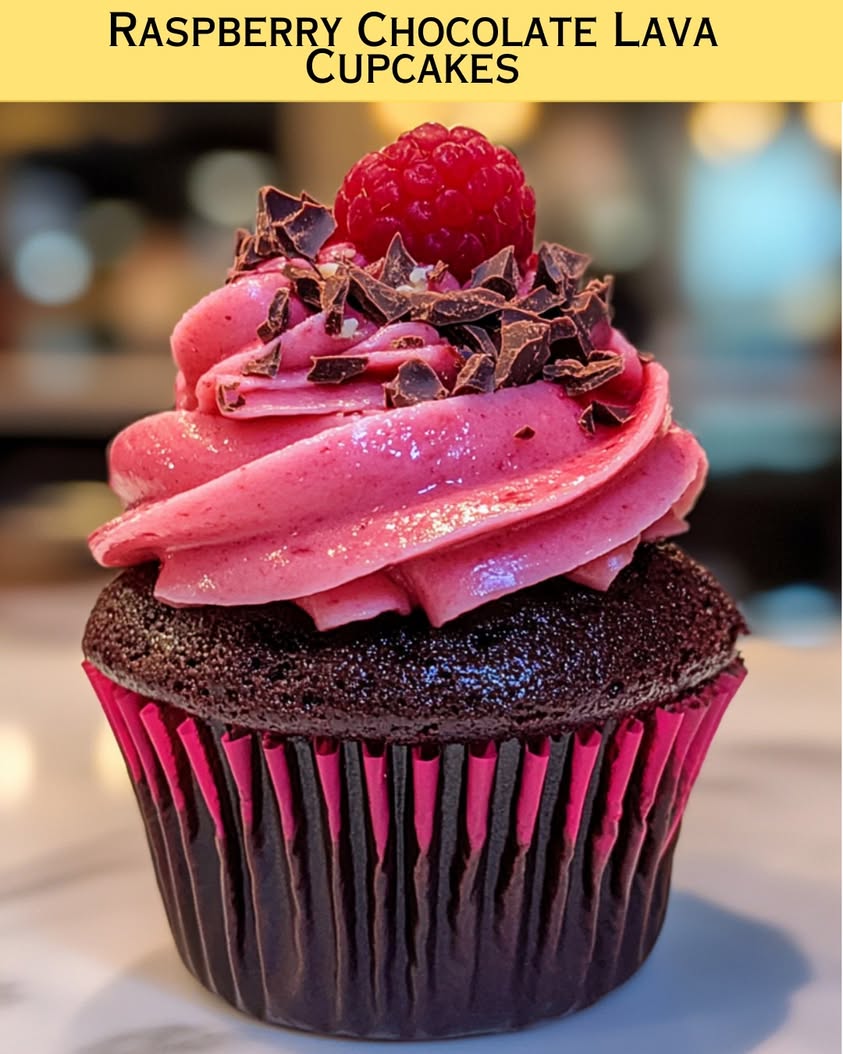Valentine’s Day Rice Krispie Treat Cupcakes: Sweet Surprises for Your Loved Ones
Celebrate this Valentine’s Day with a delightful treat that’s sure to impress! These Valentine’s Day Rice Krispie Treat Cupcakes are not just a visual feast; they taste as enchanting as they look. Imagine biting into a moist, buttery cupcake topped with a fluffy marshmallow frosting, all while enjoying the delightful crunch of Rice Krispies that add a playful texture. Perfect for sharing with your special someone, these treats are a sweet reminder of the joy of giving and indulging in each other’s company.
Crafted with love and easy to make, these cupcakes are perfect for any Valentine’s Day celebration. They’ll delight your guests and family with their charming appearance, and the familiar flavors will evoke fond memories. With a fun and colorful design, each Rice Krispie Treat Cupcake embodies the spirit of love and creativity, making it an excellent choice for friends, kids, and couples alike. Gather your ingredients, and let’s make something memorable together!
Quick Recipe Highlights
- Flavor Profile: These cupcakes mix the nostalgic flavors of butter and marshmallows with a hint of vanilla, creating a sweet treat that satisfies every sweet tooth.
- Texture: Soft and fluffy from the cupcake base, complemented by the chewy marshmallow frosting and the crunchy Rice Krispies on top.
- Aroma: The delightful scent of melting butter and vanilla fills your kitchen, creating an inviting atmosphere that adds to the excitement of baking.
- Visual Appeal: Decorated with bright pink and red sprinkles and topped with a generous cloud of marshmallow frosting, they are eye-catching and festive.
- Skill Level Needed: Perfect for beginners and children, the recipe requires straightforward techniques that anyone can master with minimal supervision.
- Special Equipment: Just basic baking equipment like cupcake pans, mixing bowls, and a mixer for the frosting is required.
Recipe Overview
- Difficulty Level: The easy level of this recipe makes it ideal for family baking sessions or a fun date night in the kitchen, ensuring everyone can participate.
- Category: These cupcakes fit perfectly within dessert categories, ideal for sweet tooth cravings or festive occasions.
- Cuisine: Influenced by classic American dessert traditions, Rice Krispie treats take a beloved staple and elevate it into cupcake form for any celebration.
- Cost: A budget-friendly dessert option, most ingredients are commonly found in your pantry, ensuring a minimal cost without sacrificing flavor.
- Season: Valentine’s Day is the perfect occasion for these cupcakes, celebrating love and affection and providing a delightful treat any time of the year.
- Occasion: These cupcakes are excellent for parties, school functions, or simply as a sweet surprise for your loved ones on Valentine’s Day.
Why You’ll Love This Recipe
The taste and texture of these Rice Krispie Treat Cupcakes are simply irresistible. The soft, fluffy cupcakes combined with a rich marshmallow frosting create a decadent dessert that’s both sweet and satisfying. Plus, the playful crunch from the Rice Krispies brings a delightful contrast, making each bite a fantastic experience for your taste buds.
Convenience is another key feature of this recipe. With easy-to-find ingredients and simple steps, you can whip these treats up in no time, making them a great choice for any spontaneous celebration. You can easily involve the kids to make folding in the Rice Krispies a fun and interactive process, bringing everyone into the kitchen.
In terms of nutrition, while they may be a sugary treat, they do provide a dose of carbs for energy, especially appealing for active kids or during festive gatherings. Pairing these cupcakes with fruits or lighter snacks can balance their sweetness, making them a fun part of a larger meal or snack spread.
On the social side, sharing these cupcakes with friends and family is a great way to spread joy. They make perfect gifts for classmates, co-workers, or loved ones and serve as fantastic conversation starters at any gathering, showcasing your creativity.
Finally, cost-effectiveness makes this recipe even more attractive. With just a few pantry staples, you can create an impressive array of delicious cupcakes that wouldn’t break the bank, making it a budget-friendly choice for any gathering.
Historical Background and Cultural Significance
Rice Krispies treats have been a beloved treat in American homes since the 1930s. They originated from a simple recipe created to promote Rice Krispies cereal and quickly gained popularity for their simplicity and deliciousness. Over the years, this dessert has evolved through various adaptations and creative spins, especially for occasions like birthdays and Valentine’s Day.
As an embodiment of nostalgia, these cupcakes connect generations. Many parents fondly recall making Rice Krispies treats with their families and now enjoy teaching their children the same process, creating treasured memories together. This recipe embodies the essence of sharing love through food, making it culturally significant in holiday celebrations.
The cupcake evolution also plays a crucial role in the history of desserts. By transforming a classic snack into a portable, easy-to-eat form, it appeals to modern lifestyles and the increasing demand for convenience in our meals and snacks.
Regional variations have also emerged, with different cultures adding their unique twists. From chocolate drizzles to colorful sprinkles, adaptations can be seen across the globe, making each Rice Krispie treat unique and personalized to fit local tastes and traditions.
Ingredient Deep Dive
Rice Krispies: A cornerstone of the treat, Rice Krispies are crispy rice cereal that adds texture and crunch. They are low in calories but rich in carbohydrates, making them a quick energy source. When selecting Rice Krispies, look for fresh options, ensuring they maintain their crunch. Store them in a sealed container to keep them crisp.
Marshmallows: A key ingredient that brings sweetness and a chewy texture, marshmallows are made from sugar and gelatin. They not only add flavor but also affect the texture and moisture content of the cupcakes. When choosing marshmallows, pick soft, fluffy options for the best results. Store them in an airtight container to maintain freshness.
Common Mistakes to Avoid
- Using stale Rice Krispies: Ensure your cereal is fresh to maintain the right crunchiness.
- Overheating the marshmallows: Heat them just until melted to avoid a tough texture.
- Not greasing the cupcake pan: Failing to grease can make it difficult to remove the cupcakes.
- Overmixing the batter: Overmixing can cause dense cupcakes, affecting their lightness.
- Skipping refrigeration: If the frosting isn’t set well, it can slide off the cupcakes.
- Using too little or too much butter: Accurate measurements ensure proper blending and a tasty outcome.
- Cooling time: Rushing the cooling phase can lead to cupcakes that crumble or fall apart.
- Not decorating immediately: Decorate while the frosting is still slightly warm for better adherence of decorations.
Essential Techniques
Mastering the melting of marshmallows is crucial for achieving the perfect consistency in the frosting. Make sure to melt slowly over low heat, stirring constantly, to avoid burning.
Incorporating the Rice Krispies evenly into the mixture is also important. Gently fold them in to maintain their crispiness while ensuring an even distribution throughout the frosting.
Pro Tips for Perfect Valentine’s Day Rice Krispie Treat Cupcakes
1. Use fresh ingredients for the best flavor and texture.
2. Adjust the amount of butter based on your preference for richness.
3. Experiment with flavor extracts like almond or peppermint for a twist.
4. Let the cupcakes cool completely before frosting for best results.
5. For a firmer frosting, refrigerate the cupcakes after frosting for about 30 minutes.
6. Be creative with your sprinkles and decorations to make your treats stand out!
7. Customize cupcake sizes using mini cupcake pans for bite-sized treats.
8. Pair with fresh fruits on the side for a delightful balance of sweetness.
Variations and Adaptations
Consider incorporating different cereals for unique flavors. Fruity cereals can add a fun twist, particularly for children, while chocolate cereals can satisfy chocolate lovers.
Seasonal adaptations can also be fun; for instance, add crushed peppermint for winter holidays or citrus zest for a light spring flavor.
For dietary modifications, swapping regular marshmallows with vegan options creates a delightful treat for those on plant-based diets.
Flavor variations might include adding chocolate chips or caramel bits into the mixture for an indulgent experience.
You can also enhance texture by adding nuts, such as crushed almonds or walnuts, for a delightful crunch contrasted with softness.
Presentation alternatives such as placing cupcakes in charming muffin liners or adding themed cupcake toppers can elevate the visual appeal for special occasions.
Serving and Presentation Guide
When plating your cupcakes, consider using colorful liners and arranging them on a decorative cake stand for an inviting display. The colorful frosting should be swirled attractively on top of each cupcake, with playful sprinkles added for a festive touch.
Garnishing ideas include fresh berries or edible flowers to enhance visual appeal while providing a flavor contrast. Traditional accompaniments like chocolate sauce or fruit coulis can add an extra layer of flavor.
Modern serving suggestions can include pairing cupcakes with tea or coffee, creating a sophisticated dessert experience. Temperature is key—serve them at room temperature so that the frosting maintains its delightful texture.
Finally, portion control is important, especially in gatherings; accompany these cupcakes with smaller desserts or fruit platters for a balanced dessert table.
Wine and Beverage Pairing
Pairing these delicious cupcakes with sweet dessert wines such as Moscato or a fruity Riesling can enhance the flavor and complement the sweetness. Champagnes and sparkling wines also offer a celebratory touch, perfect for entertaining.
For non-alcoholic alternatives, consider serving flavored sparkling waters or a berry-infused lemonade to add freshness that balances the sweetness of the cupcakes.
If coffee is more your style, a light roast with fruity notes pairs beautifully, as does a rich hot chocolate for a cozy twist.
Storage and Shelf Life
To store these cupcakes, place them in an airtight container at room temperature for up to three days, ensuring they maintain their softness and freshness. For longer storage, refrigerated options can last up to a week.
Signs of spoilage include changes in texture or odor; if they feel dry or develop a hard crust, it’s best to discard them. Reheating is generally not recommended, as it can affect the frosting.
For freezing, wrap each cupcake tightly in plastic wrap, then place them inside a freezer-safe container. They can be frozen for up to two months. Thaw overnight for the best results before serving.
Make Ahead Strategies
To save time, prepare the cupcake batter a day in advance and store it in the refrigerator; just remember to bring it to room temperature before baking. You can also make the frosting ahead of time and store it separately.
Quality impacts can arise if cupcakes are frost too early; it’s best to frost them the day of serving. Easily keep the cupcake bases stored while waiting to frost.
Incorporate fresh elements such as berries or whipped cream right before serving, ensuring they remain bright and appealing.
Scaling Instructions
When halving the recipe, ensure to adjust sizes of the cupcake liners and baking times; mini cupcakes will require less time than standard-sized ones.
Doubling or tripling the recipe may necessitate additional mixing bowls or baking trays. Larger quantities can also be baked in batches to maintain even cooking.
Timing modifications are crucial; monitor closely if altering baking times and pay attention to the cooling phases to ensure they set correctly.
Nutritional Deep Dive
These cupcakes provide a delightful balance of carbohydrates and protein from the marshmallows, vital for energy. However, be mindful of portion sizes, as they can be calorie-dense due to high sugar content.
In terms of micronutrients, small amounts of iron from cereal can be beneficial, but these cupcakes are not likely to replace nutritional needs. Pairing with fruits can round out the diet for a bit of fiber.
Keeping portion analyses in mind ensures that you can enjoy these treats in moderation, which is perfect for special occasions or holiday celebrating.
Dietary Adaptations
For gluten-free options, check the labels on your Rice Krispies as some may contain gluten. Alternatives are available that cater to this dietary necessity.
Dairy-free adaptations include using almond or coconut based ingredients for frosting. There are several plant-based butter options available that can mimic traditional flavors effectively.
If you’re looking for a vegan version, use vegan marshmallows and plant-based butter to maintain the essence of the recipe without animal products.
For low-carb or keto diets, substitute traditional marshmallows with sugar-free alternatives and explore recipes that utilize nut flours instead of grains for the cupcakes.
Paleo diets may also benefit from variations using honey instead of sugar and incorporating ingredients allowable under this dietary plan.
Troubleshooting Guide
If the texture of the cupcakes is too dense, make sure not to overmix the batter. This common mistake can lead to heavy results, affecting taste and texture.
A flavor balance issue can arise if the marshmallow frosting is too sweet; consider adding a pinch of salt to round out the sweetness and enhance flavors.
Temperature problems during baking can lead to uneven cupcakes. Always use an oven thermometer to ensure consistency and check for doneness with a toothpick for best results.
For equipment challenges, make sure to follow your specific oven’s guidelines as baking times can vary depending on the model.
Ingredient substitutions can sometimes lead to unexpected results. If changing key elements, keep ratios consistent and follow guidelines to maintain balance.
If timing concerns arise, be deliberate about preheating or letting ingredients reach room temperature to ensure batter consistency and balance of flavors.
Recipe Success Stories
Many community members rave about how easy these Rice Krispie Treat Cupcakes are to make, leading to creative adaptations, from flavor twists to elaborate decorations that capture unique occasions.
Success stories often involve variations made to cater to specific dietary needs, such as vegan or gluten-free adjustments that still lead to rave reviews.
Reader suggestions often reflect personal touches that make the recipe stand out, whether through additional flavorings, enhanced presentation, or festive sprinkles that add character.
Photography tips shared within foodie communities highlight different ways to showcase these cupcakes, encouraging vibrant backgrounds and creative food styling for social media sharing.
Frequently Asked Questions
Can I make these cupcakes in advance? Yes, you can make the cupcake bases ahead of time. Frosting is best done just before serving to maintain freshness.
How do I prevent the marshmallow frosting from being too sticky? Using a touch of cornstarch to your frosting may help achieve a less sticky consistency.
Can I use flavored Rice Krispies for an extra twist? Absolutely! Flavored cereals can add an adventurous touch to your cupcakes.
What should I do if my cupcakes are dry? Ensure you’re measuring ingredients accurately and not overbaking to maintain moisture.
Can I freeze these cupcakes once decorated? It’s best to freeze the cupcakes without the frosting—frost them after thawing for best results.
Is it possible to double the recipe for a larger event? Yes, you can easily double the ingredients and bake them in batches!
How can I customize the frosting? Add extracts like vanilla or almond for additional flavors, or mix in food coloring for a festive touch.
Can I mix in other ingredients like chocolate chips? Definitely! Chocolate chips add a delightful surprise and richness to the cupcakes when mixed in.
Do I have to use butter? For dairy-free options, substitute butter with margarine or a dairy-free spread.
What if I want to make mini cupcakes? Simply adjust your baking time, as mini cupcakes require less time in the oven.
Additional Resources
Explore our collection of dessert recipes for more delicious options to satisfy your sweet cravings. For tips on baking techniques or ingredient guides, our archives are filled with helpful posts to elevate your cooking skills.
Looking for the perfect baking equipment? Check our recommendations for quality tools that make home baking easy and enjoyable.
Seasonal variations can enhance your dessert game—be sure to check back each season for exciting new recipes and holiday-themed ideas.
Join the Conversation
Connect with us on social media to share your baking stories and photography tips! Join our community of passionate bakers who love to share tips, variations, and feedback on recipes. It’s a great way to engage with others who share your passion!
Don’t forget to leave a review after trying this recipe, and share your personal twists to inspire others!
The Recipe
Valentine’s Day Rice Krispie Treat Cupcakes
Serves: 12 cupcakes
Prep Time: 20 mins
Cook Time: 10 mins
Total Time: 30 mins
Kitchen Equipment Needed
- Mixing bowls
- Mixer (hand or stand)
- Measuring cups and spoons
- Cupcake pan
- Spatula
- Plastic wrap (for storing)
Ingredients
- 1 cup unsalted butter
- 5 cups mini marshmallows
- 6 cups Rice Krispies cereal
- 1 teaspoon vanilla extract
- Pink and red sprinkles for decoration
- Optional: Food coloring for frosting
Directions
- Preheat the oven to 350°F (175°C) and line the cupcake pan with liners.
- In a large saucepan, melt the butter over low heat. Once melted, stir in the marshmallows and vanilla extract until completely melted and smooth.
- Remove from heat and gradually stir in the Rice Krispies, ensuring they are well coated.
- Scoop the mixture into the prepared cupcake liners, pressing gently to form a base.
- Allow the cupcakes to cool for about 15 minutes.
- Once cool, prepare the frosting by beating additional marshmallows with butter and food coloring until fluffy.
- Frost the cupcakes generously with marshmallow frosting and decorate with sprinkles.
- Serve immediately or store in an airtight container for later enjoyment.
Recipe Notes
- For a richer flavor, experiment with adding chocolate chips to the Rice Krispies mixture.
- Refrigerate cupcakes after frosting to help the frosting set, especially if they are made in advance.
